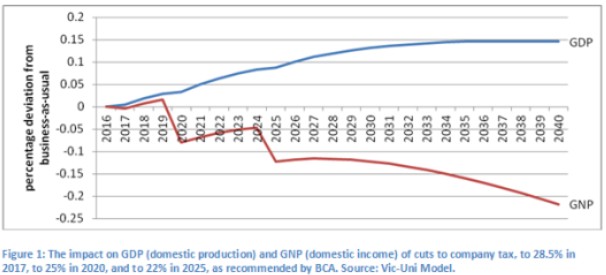Treasurer Scott Morrison revealed in parliament yesterday that the full cost of the Coalition’s proposed company tax cut would be $15 billion a year – significantly higher than previous estimates. From The ABC:
The Federal Government’s full company tax plan will cost the budget more than $15 billion per year once fully implemented.
The revised figures were outlined by Treasurer Scott Morrison during Question Time, prompting Labor MPs to accuse the Government of a multi-billion-dollar blowout…
Mr Morrison has revised that figure to $65.4 billion for the decade starting a year later, on July 1, 2017 (2017-28).
The increase takes into account forecast economic growth and increasing company tax profits, which would be paid if the tax cut is not passed for all businesses.
The Government has already passed the first tranche of the tax cuts for businesses with an annual turnover of up to $50 million, in exchange for energy reviews and one-off payments for pensioners.
It has committed to passing the tax cuts for all businesses at a later stage.
Opposition Leader Bill Shorten called on Government to explain how it would fund a $65 billion “corporate tax give-away” and accused the Government of having five different versions of the total cost.
But Mr Turnbull sought to “clear up what appeared to be some confusion”, saying the tax cuts had been fully funded and insisted the budget would return to surplus in 2020/21.
The modelling of the company tax cut package conducted by Independent Ec0nomics on behalf of the Australian Treasury estimated that the full company tax cut package would cost $11.3 billion per year. However, this would be reduced to $8.2 billion due to “a gain in personal income tax and superannuation income tax of $3.1 billion as the cut in company tax automatically reduces the value of franking credits”.
Regardless, the revised $15 billion a year cost (presumably excluding the impact of franking credits) does represent a significant increase on prior estimates, even though it comes via a shifting of the theoretical start date from 1 July 2016 to 1 July 2017, rather than an actual blowout in the cost of the package. It also gives Labor an alarming optic to attack the Coalition on.
The bigger issue, in my view, is that Treasury’s modelling showed almost zero impact on ‘jobs and growth’ despite its enormous cost. As explained by The Australia Institute’s Richard Denniss:
According to Treasury’s in-house modelling, and the modelling it commissioned from Chris Murphy, if the company tax rate is lowered from 30 per cent to 25 per cent then gross domestic product will double by September 2038, while without the tax cut it won’t double until December 2038. Wow, a whole three months earlier. Both modelling exercises conclude that in 20 years’ time the unemployment rate will be 5 per cent regardless of whether we spend $50 billion on company tax cuts or not…
The “benefits” are more accurately described as rounding error than significant reform.
Separate modelling from Victoria University senior research fellow, Janine Dixon, also found that cutting the company tax rate could actually lower national income (GNP) and living standards because of the benefits flowing offshore:

The fact that the Turnbull Government remains committed to passing the full company tax cut package in the future – despite its huge cost, immaterial economic benefits, and general unpopularity within the electorate – shows that it has a shocking tin ear. It should have dumped the plan in the Budget alongside the zombie measures from past Budgets.

